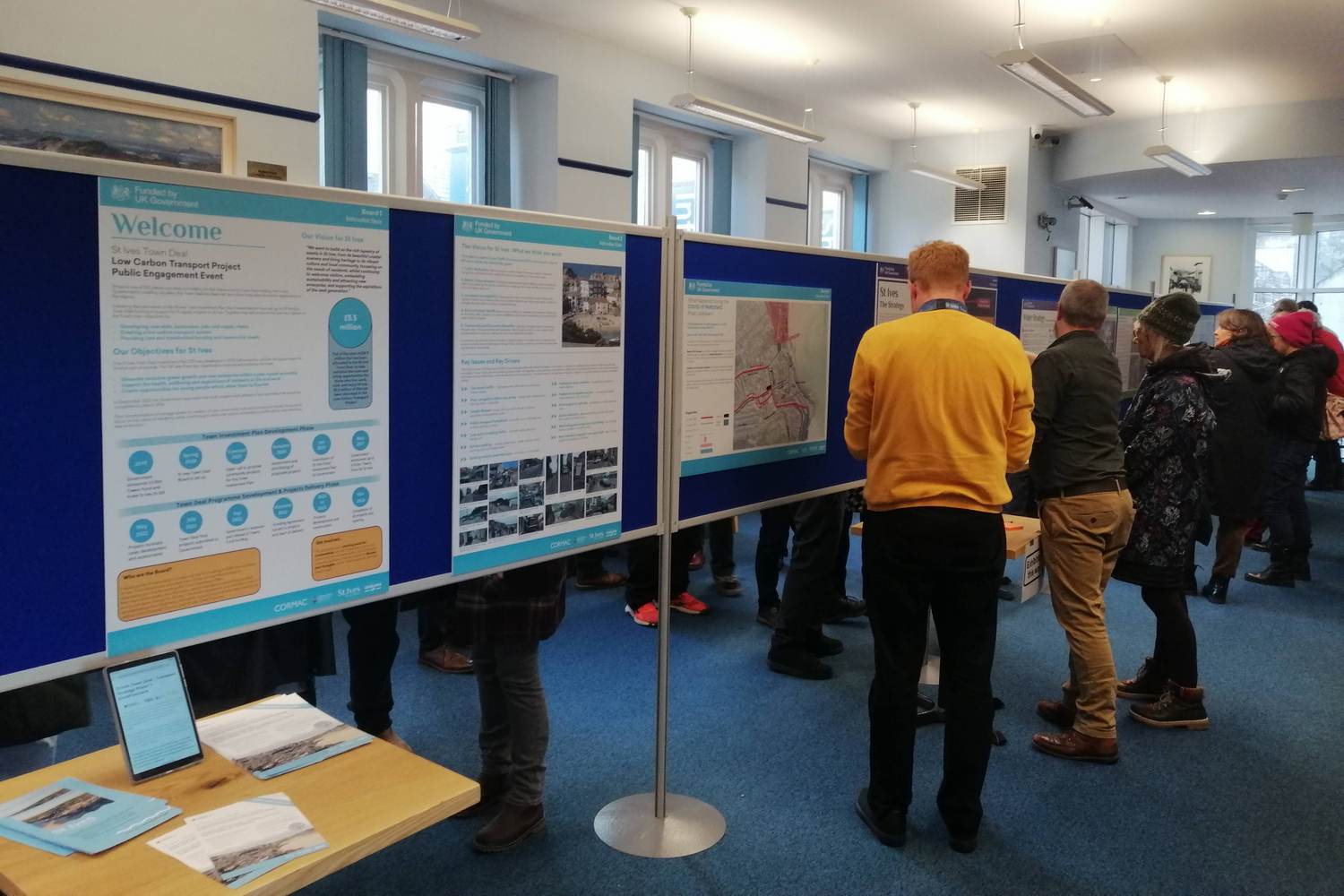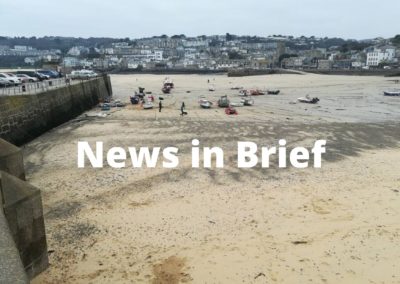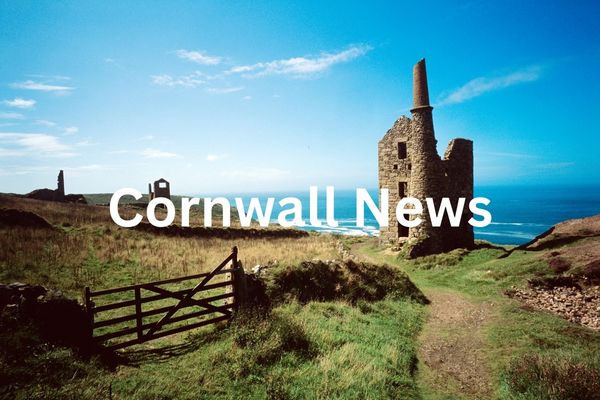The report outlining the findings of the public engagement carried out into the St Ives Low Carbon Transport Strategy is now available to view.

An exhibition showing the transport plans, held in the library in November
The strategy is being funded and delivered as part of the St Ives Town Deal programme. It aims to help reduce the impact of vehicles on St Ives, and introduce measures that encourage walking, cycling, and the use of public transport.
The project has been allocated £5.5 million of Town Deal funding to create a Low Transport Environment (LTE) within the town centre by reducing traffic, enhancing safety, increasing accessibility, improving environmental health, and delivering community and economic benefits. This funding needs to be spent by March 2026. Longer-term measures will need to be funded from other sources.
Members of the public were asked for their views on the draft proposals via a comprehensive consultation programme. This included an online survey and a public exhibition in the town’s library. More than 450 people took part in the consultation.
Of those taking part in the consultation:
- The majority were local residents of St Ives.
- Sixty-three business owners responded to the survey.
- Nine per cent of people identified as having reduced mobility.
- The majority of respondents visited the town more than once a week.
- The majority of respondents visit the town centre for less than one hour.
- A large number of respondents use the high street for traditional reasons such as food shopping and banking, as well as leisure activities and eating out in cafés/restaurants.
- The joint most popular methods of travel to St Ives by respondents were walking and driving (combining drivers and passengers).
- The respondents stated there was too much traffic in the town centre of St Ives as a whole.
- The quality of walking is seen as poor by many respondents due to congested streets, with pedestrians sharing the road with cars due to a lack of pavements. Measures to address this are seen as being of highest priority by respondents.
- There is a mixed view on cycling, but across divides respondents would like dedicated cycle infrastructure to keep cyclists safe from cars and pedestrians safe from bikes. This was, however, seen as being significantly the lowest priority.
- The view of public transport provision is positive overall, but there are widespread concerns about a lack of space, seating, and shelter at bus stops, as well as a demand for increased regularity and reliability of services. This was of high priority compared to most other measures proposed.
The results indicate there is a potential demand for improved parking facilities in St Ives. The survey was conducted in winter when the number of tourists is significantly lower than in peak months. However, the data suggests that a significant proportion of people that parked either on the street or in pay and display car parks found it fairly difficult or very difficult to find a parking space.
A high proportion of respondents, and therefore residents, walk into St Ives town centre more than once per week. The least common methods of transport among respondents were cycling, using the bus, or the train.
The majority of those responding via the survey (69.9%) said that the environment in the town centre needed changing and improving, with most supporting the principles of improving walking and cycling facilities, reducing the level of traffic, and improving public transport.
Key findings included:
- There is support for improving pedestrian areas, including crossings and wider footways.
- There is support for reprioritising junction layout.
- There is support for reducing overall traffic flows.
- There were suggestions of expanding the park and ride scheme for visitor parking. This is beyond the scope of the St Ives Town Deal, but could be considered by Cornwall Council or other stakeholders as a future scheme.
- There was a general call for better enforcement of permit parking and parking on double yellow lines.
There were suggestions that live parking signs should be implemented to show remaining parking spaces within the town.
However, while there was overall support for the aims of the strategy, there were different views on how this should be achieved:
- There were 51 concerns/objections raised regarding both the rising bollards and associated traffic restrictions for access to properties and businesses, as well as regarding emergency services access.
- Fifteen individual comments had concerns around routing traffic through Halestown, with regards to lack of footways and safety.
- There were 18 comments concerning access for locals to Downalong.
- There were ten objections to the parking restrictions on Barnoon.
- There is objection to the implementing of one-way systems, making the town difficult to access.
A copy of the report an be viewed here.
The project team have spent the past two months analysing all the responses from the consultation. They have also listened to comments and concerns subsequently raised by individuals and community groups living and working in areas which could be affected by specific proposals.
As a result of the concerns over the suggestion to introduce measures such as rising bollards and barriers to restrict access to the town centre as part of the plans to create the Low Traffic Environment, the project team are looking into the use of alternative methods to discourage people without legitimate reasons from driving into the town centre during these periods.
As plans to improve the junctions at the Terrace, Stennack and Higher Stennack, and Malakoff, received a largely positive response from the majority of respondents, work is continuing to develop these schemes.
The project team have also been listening to the concerns raised by people living in areas outside the town, such as Halsetown, who are worried about the redirection of more holiday and day visitor traffic into St Ives along the coach road and the current lack of footways. Further work is being carried out to assess the level of traffic which could be created by the proposal, together with the development of measures to mitigate the potential impact from this.
Further work is also being carried out on the draft proposal to introduce a one way system around Library Corner and up Tregenna Hill, and the reversing of the existing one-way restriction on Park Avenue.
A report outlining the amended plans for the mid town centre and Low Traffic Environment and one-way system is currently due to be considered by members of St Ives Town Board at its meeting in May.
Following the meeting, details will be published on the Let’s Talk Cornwall site and the St Ives Town Deal website, with plans also being developed for a exhibition at the town’s library which will provide information about the strategy and the timetable for delivering the different elements.




